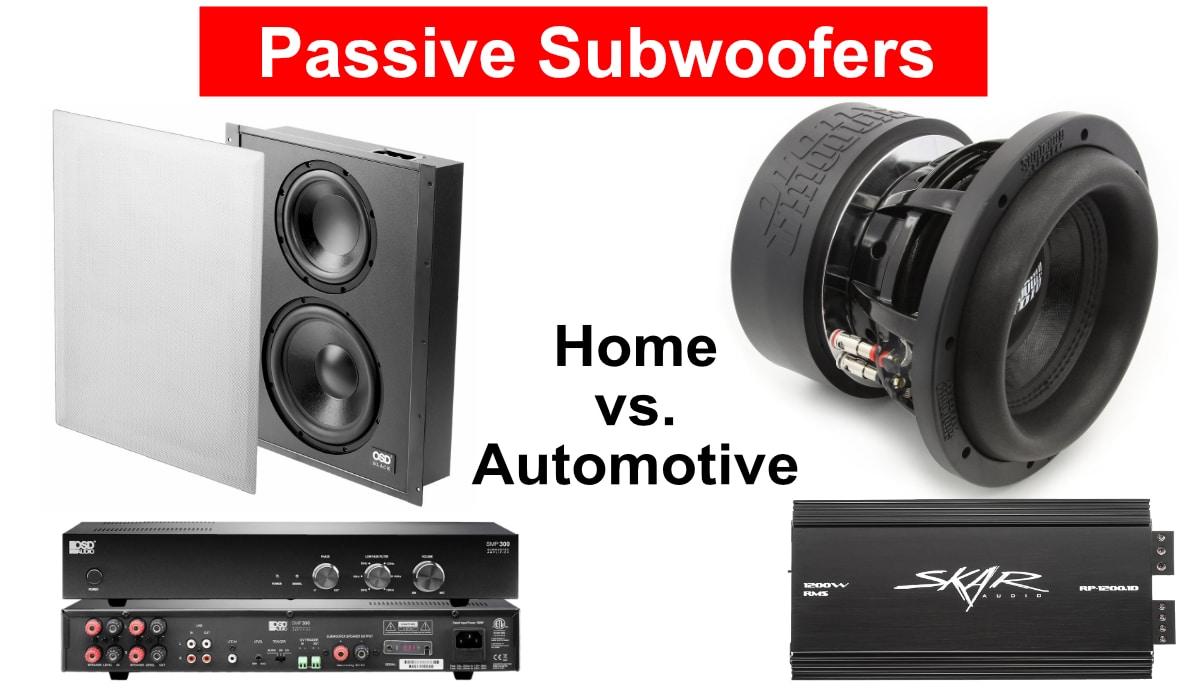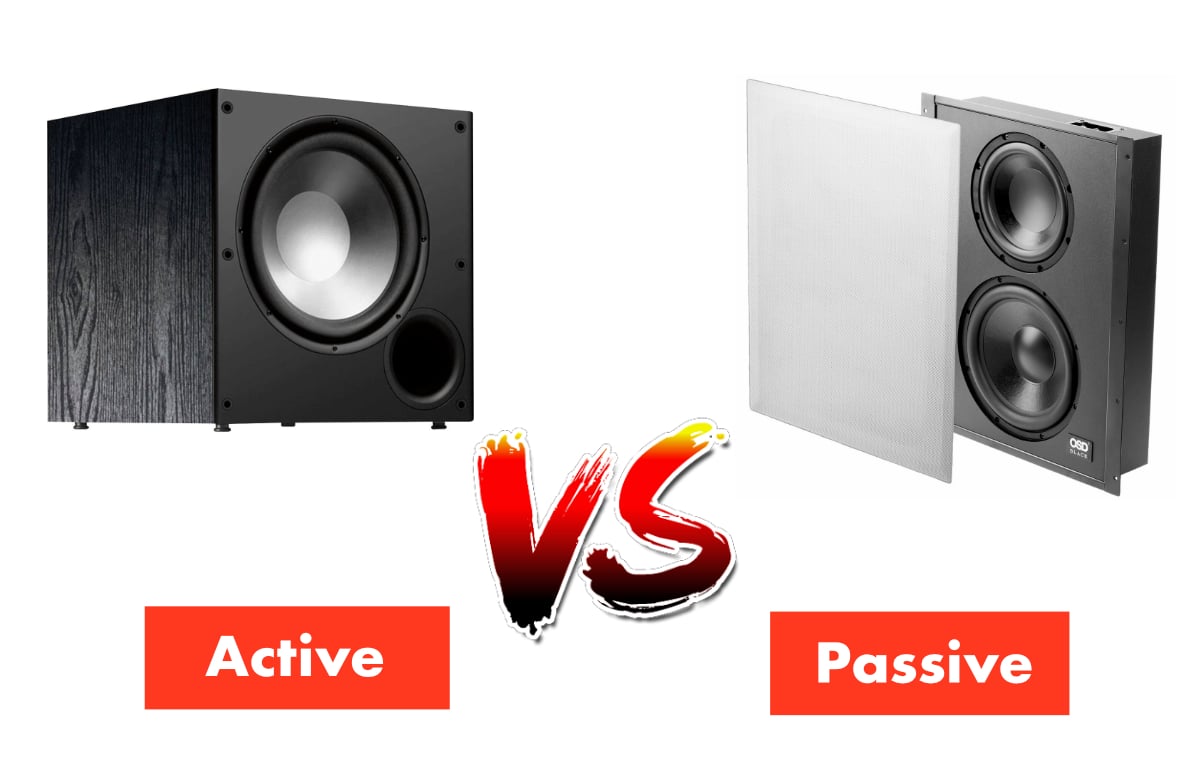What Is A Passive Subwoofer? [Active vs Passive Explained]
What is a passive subwoofer? A passive subwoofer is a loudspeaker dedicated solely to reproducing the low frequency sound in audio systems. It is typically used to supplement the bass sound from other speakers and can provide a greater range of sound for the listener.
A passive subwoofer does not have its own power source and must be powered by an amplifier. They are designed to be connected to an audio/video receiver, preamplifier, or integrated amplifier to produce low-frequency audio. Passive subwoofers can be found in both powered and non-powered configurations.
The powered version typically has an amplifier built-in, while the non-powered version does not. Overall, a regular passive sub is a specialized speaker that can reproduce extremely low frequencies and bass sounds with the help of an external amplifier. Passive subs can also be powered by an internal amp or (A/V) receiver.
The amplifier or receiver must be able to output sufficient power to drive your subwoofer without depleting its power or the amplifier’s power supply, which would leave insufficient power for your other speakers. Let’s define a passive subwoofer and give a quick active subwoofer comparison so you can understand the differences.
How a Passive Subwoofer Works
A passive subwoofer is a type of loudspeaker designed to reproduce lower-frequency sound than its traditional counterparts. It is typically used in home theater systems and can greatly enhance the sound quality of movies and music.
Plus, the most common type of passive subwoofer contains two parts: the cabinet and the driver. The cabinet houses the driver and sits behind the main speakers.
The driver is a large speaker cone that is responsible for producing low frequencies. It is connected to an amplifier, which boosts the sound waves that the driver produces.
The way a passive subwoofer works is by using the power of the amplifier to send an audio signal to the driver, which in turn vibrates the air around it.
Types of Passive Subwoofers

Passive subwoofers are an essential component of any home theater system, providing the deep bass notes needed to create an immersive audio experience. Here are the main types of passive subwoofers, each with its own set of advantages and disadvantages.
Sealed Enclosure Subwoofers
These types of subwoofers are often smaller in size and offer optimal performance in small spaces. They are often used in home theater systems and offer a great balance of sound quality and power efficiency. They work best when used in small- to medium sized rooms and can be positioned in a variety of locations.
Ported Enclosure Subwoofers
These subwoofers are designed with a port or vent on their enclosure, allowing them to move more air and therefore produce deeper bass. They are great for home theaters, as they can provide a powerful punch and deep rumbles, perfect for that cinematic experience. They are also relatively efficient, making them a good choice for those looking to save on power consumption.
Bandpass Subwoofers
Bandpass subwoofers are designed to offer incredible sound quality and bass response, making them ideal for those who want to experience the best sound possible. They feature an enclosure that contains both a bass reflex and a sealed chamber, allowing them to produce deep bass frequencies with excellent accuracy.
Acoustic Suspension Subwoofers
This type of enclosure produces more accurate bass notes than traditional bass reflex enclosures and is generally well-suited for small to mid-sized rooms.
The low-frequency sound produced by acoustic suspension subwoofers is tight, punchy, and accurate, making them ideal for those who prefer the sound of the original recording.
Free Air Subwoofers
These types of subwoofers are designed to be mounted in an enclosure, such as a trunk or hatchback, and are powered by the existing head unit.
The advantage of free-air subwoofers is that they don’t require the large, bulky enclosures of other subwoofers, making them easier to install and more aesthetically pleasing.
Connecting Speaker Wires to A Passive Subwoofer
Connecting speaker wires to a passive subwoofer can be a straightforward process. To begin, locate the subwoofer input terminals on the back of the subwoofer. This can typically be found in the form of either two spring-clip terminals or two sets of binding posts.
If your subwoofer has two sets of binding posts, each set will usually be labeled with a + and – symbol, indicating the positive and negative terminals, respectively.
After finding the input terminals, run the speaker wire between the corresponding terminals on the subwoofer and the amplifier or receiver. If you are using spring clips, ensure a secure connection by pushing each spring clip firmly onto the wire.
Advantages of Passive Subwoofer
Passive subwoofers are an essential part of any stereo system, providing a powerful and rich low-frequency sound. They are designed to extend the range of sound, creating a fuller and more dynamic audio experience.
Here are the advantages of using a passive subwoofer:
Increased Volume
The most obvious benefit of using a passive subwoofer is an increased volume. Passive subwoofers produce more powerful, low-frequency sound waves, which can dramatically increase the volume of a room. This is especially useful for music and movie enthusiasts who want to enjoy their media at higher volumes.
Enhances low-frequency sound
The subwoofer can provide a noticeable improvement in the low-frequency sound, which can create a dramatic difference in the quality of your sound. This can be particularly noticeable in movies and video games, where the sound can be accentuated by the use of a subwoofer.
Reduces distortion in audio reproduction
Passive subwoofers help to reduce distortion, which can be caused by the compression of high-frequency signals or the distortion of low-frequency signals. The result is a much clearer, more accurate sound.
How Many Subs Do you Need in your Home Theater?
Subwoofers are designed to provide low-frequency sound, which gives movie soundtracks and music a greater sense of depth and realism.
But how many subwoofers do you need in your home theater? Generally speaking, only one subwoofer is usually sufficient.
That’s because most home theater receivers feature bass management technology, which allows you to adjust the frequency response of your speakers so that the subwoofer can take over the job of producing low-frequency sound.
In most cases, one subwoofer is all you need to get a decent bass response without the need for multiple units.
What are Active Subwoofers?
An active subwoofer or powered subwoofer are loudspeakers that can be used to produce low-frequency sound. They are designed to enhance the sound of audio systems, providing an extra layer of bass or low end.
Active subwoofers are different from passive subwoofers because they have an amplifier built into the speaker unit. This allows for greater flexibility when controlling the sound of subwoofer output, as the amplifier can be adjusted to reproduce low frequency sounds.
Active subwoofers are usually used for either a home theater sound system, concert halls, or other large sound systems. You can use an active subwoofer to add extra bass to your own home theater system.
Active vs Passive Subwoofer: Which One Need An External Amplifier?

What is a passive and active subwoofer? When it comes to setting up a home theater receiver, music studio, or professional event, you want to be sure you are using the best equipment for the job.
Subwoofers are an important component of any stereo system, and there are two main types to consider: passive and active subwoofers. It can be confusing to know the difference between the two and which one may be the right fit for your sound system.
Active subwoofers, also known as powered subwoofers, have an integrated amplifier, meaning they are self-powered. This makes them much more convenient, as they don’t require separate amplification.
All you need is a power source, and you’re good to go. Active subwoofers also usually have more sophisticated features like adjustable crossover points, allowing you to optimize the sound to your own preferences.
Passive subwoofers, on the other hand, require an external amplifier to power them. This means that you will need to buy a separate amplifier to power the subwoofer in order to get the sound you want.
Active and Passive Subwoofers on Wireless Connectivity
Subwoofers increase the bass and low-end frequency range of the sound system. There are two types of subwoofers: passive and active subwoofers.
When it comes to wireless connectivity, there are some important considerations to keep in mind when choosing between an active or passive subwoofer.
An active subwoofer is powered by a built-in amplifier and has its own power source. This allows for greater flexibility in terms of placement, as the subwoofer can be placed anywhere in the room, not just near a power supply.
An active subwoofer also provides better sound quality and is typically more powerful. A passive sub, on the other hand, needs an external power source and must be connected to an external amplifier.
Passive subwoofers, on the other hand, need to be connected to a receiver or amplifier to work, so they must be placed near an outlet. This can limit the placement options for the subwoofer and make it difficult to achieve the desired sound. You will also consume more power than active subs.
Other Connectivity Options for Passive Subwoofer
Another popular and reliable option for connecting a passive subwoofer to an audio system is through a wired connection. Wired connections give a more direct and reliable connection between the subwoofer and the audio system. This is great for those who are looking for a more consistent sound and better control over the bass output.
Another option for connecting a passive subwoofer to an audio system is through the use of an amplifier. A powered sub can reproduce low frequency sound output with greater accuracy and clarity than a passive sub.
There are wireless passive subs that can be connected to an amplifier, allowing the user more flexibility in placement and setup. This wireless connection option is useful when there is no easy way to connect the subwoofer directly to an amplifier or when there is a desire to avoid unsightly and possibly tangled cables.
An amplifier will give the subwoofer more power and will provide more control over the output of the subwoofer. This is a great choice for those who want more flexibility in their sound. To determine how much power the passive subwoofer requires, you need to check the manufacturer’s specifications.
Last Updated on: March 16, 2025

